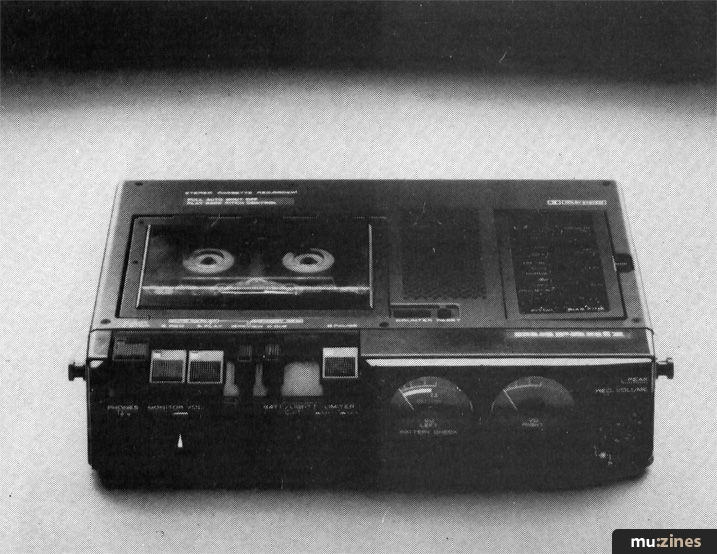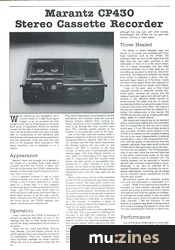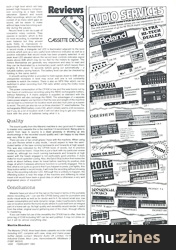Magazine Archive
Home -> Magazines -> Issues -> Articles in this issue -> View
Marantz CP430 Stereo Cassette Recorder | |
Article from Home & Studio Recording, February 1985 | |

When setting up any installation, be it a home studio on a tight three figure budget, or an oil rig where the final budget could vary by three figures in the total, each piece of equipment should be carefully chosen for the task it must perform. If equipment can be found to fulfil more than one task with no compromise on the efficiency with which those individual tasks will be performed, and the equipment costs less than the total price of the separate items required to fulfil these functions, one is definitely on to a winner.
Appearance
Marantz have just brought out a winner in the shape of a portable three head stereo cassette recorder, the CP430. It takes over from an old favourite, the CD330, retaining the benefits of this model whilst introducing some new ones of its own.
It is a pleasant surprise to see so many features packed into such a small unit. The CP430 is only 9 inches wide and 6½ inches deep by 2 inches high. It is very ruggedly constructed and is further protected by a very tough, rigid PVC-type case which does up firmly all round it with press-studs and flaps to allow rapid access to all the vital controls. When removed from this case in the safety of the home studio, the CP430 appears very smart, functional and professional.
Operation
Every control on the CP430 is recessed to prevent accidental alteration of any of the settings and also to offer added protection should the thing inadvertently be knocked or dropped.
There are the usual Eject/Stop, Record, Play, Review, Cue and Pause controls, all of which operate firmly and smoothly and require no explanation. There are, however, some extra functions available via these controls. Whilst the unit is in playback mode with the Play switch depressed, it is possible to shuttle backwards and forwards using the Cue and Review buttons without them locking on. Rapid searching is thus possible without the need to go through the 'stop' position each time. This, naturally, greatly speeds up the location of any particular point on the tape.
One of the slide switches located under a perspex topped lid on the top of the machine is designated Memory Rewind. With this in the 'on' position and the Play switch depressed, the Review buttons will now lock on and rewind until '000' is reached on the tape counter, at which point it automatically starts playing again. This Auto Replay function is very useful for transcribing from tape when used in conjunction with the counter reset button. As each section is successfully transcribed, be it a letter, interview or lyrics, the counter can be reset by the push of a button, transcribing continued and the Review button depressed each time the tape gets too far ahead.
Work of this nature can be further simplified on the CP430 by slowing the tape down using its pitch control. The rotary pitch control can be used to vary the tape speed on playback by plus or minus 5% with correct speed indicated by a centre detent position. This facility can also be used for correction purposes eg. to retune a recording made from a record deck that runs either a little fast or a little slow, or creatively, as I did recently, to lengthen a piece of electronic music to match the length of a vocal track for an audio-visual show.
Next to the pitch control is a fine adjustment for the bias. This is provided for matching the recorder to the high end response of any particular brand of tape. One of the easiest ways to do this is by switching between tape and source signals whilst adjusting the bias during a recording of some music that contains a regular and prominent hi-hat cymbal. When there is least difference between tape and source, the correct bias level has been achieved. I mostly used TDK tapes on the CP430 and found the centre-click position on the bias control to be very close to optimum, although this may vary with other brands. Nevertheless, the CP430 can be used with normal, chrome or metal tapes.
Three Headed
The ability to switch between tape and source is, of course, only possible with three head machines such as the CP430. The playback head can pick up the signal from the tape that has just been recorded a few millimetres in front of it by the record head. This is a great advantage over two head machines enabling you to hear what you are recording as opposed to what you should be recording. The delay time between the heads from source to playback is about 100 milliseconds (tape travels at 4.75cm/sec, heads are about 5mm apart) which just happens to be a very useful time for certain echo effects.
I have, in the past, used a three head cassette recorder to artificially 'double' keyboard parts, panning the source and the delayed keyboard signal hard left and right to achieve a very effective stereo spread on string sounds. The delay time can, of course, be extended further by taking the output of one channel to the input of the other. The output of this second channel will then be delayed by a further 100 milliseconds. In this manner, the CP430 can thus be used as a high quality tape delay, albeit of a fixed interval.
Line inputs and outputs are all via standard phono connections making this unit compatible with hi-fi equipment as well as a lot of home studio gear. A 5 pin DIN record/play socket is also provided. Another handy feature of the CP430 is its internal monitor speaker enabling the unit to be used independently of external amplification. I was a little disappointed, however, with the quality of reproduction from this speaker, although I have been spoilt by the old CD330 which had particularly good reproduction from its own speaker. The CD330 speaker was, in any case, twice the size and there has to be some compromise made on the new model to achieve such a compact unit. The internal speaker can be switched to monitor left and right channels independently or simultaneously. It can also be switched off to prevent feedback when recording by microphone. Alternatively, monitoring can be carried out on standard stereo headphones via the Phones jack socket.
Microphone inputs are standard quarter inch jack and attenuation is switchable at 0, -15 and -30dB. A microphone input socket is provided for each channel although the left socket will accept a stereo jack from a stereo microphone and route the signals accordingly. A microphone mode switch is also provided which will route a mono microphone signal to both channels. I like the inclusion of this feature as a greater tape width is being used in this mode increasing the signal-to-noise ratio and also lessening the chances of drop-outs.
Performance
The CP430 gives 55dB signal-to-noise without noise reduction and 65dB with Dolby B, both of which are good figures for a cassette machine. It also offers dbx, which gives an exceptional 80dB S/N ratio. This enables a much wider dynamic range to be recorded without noise becoming a problem, it also means that recordings need not be made at such a high level which will help prevent high frequency compression occurring as a tape nears saturation. Speech and sound effect recordings, which can often consist of as many silent gaps as sound, will be easier to make without tape noise becoming audible during the pauses.
Record level is set via a pair of concentric rotary controls. They operate in tandem, which is fine for most recording, to maintain an even balance but they proved quite fiddly to manoeuvre independently. When the machine is in record mode, a triangular red LED is illuminated adjacent to the level controls which acts as a very useful level reference indicator as well as a positive indication that record mode has been properly selected. A red peak level LED situated above the record level controls indicates signal peaks above 0dB which may be too fast for the meters to register. The meters themselves are generally very responsive and easy to read and they can be illuminated by a momentary push switch which leaves them brightly lit for about 10 seconds before going out automatically - a valuable battery-saving feature. The battery level can also be checked by holding in this same switch.
A smooth-acting limiter is provided to hold signals down to 0dB where unexpected increases in level may occur and one is not constantly available to watch the meters. There is also an MPX filter which can be switched in when recording from FM radio whilst using the Dolby noise reduction.
The power consumption of the CP430 is low and this was borne out by four hours of continuous recording using the RB40 rechargeable battery, without flattening it. A mains adaptor is supplied as standard with the CP430 which will also recharge the RB40. The advantages of a separate mains power adaptor are twofold in that the size and weight of the machine can be kept to a minimum for location work and also hum pick up is easier to avoid. The unit can also be run on three standard 'D' sized batteries. The rechargeable RB40 battery costs £30, which initially seems a bit excessive, but if you do a lot of location work it will not take long to get your money back with the price of batteries being what it is.
Quality
The sound quality from this Marantz machine is very good and if I needed to master onto cassette this is the machine I'd recommend. Being able to switch from tape to source is a dead giveaway in showing up any shortcomings in the recorded sound quality and I am happy to say there was very little to give away.
There are one or two small gripes I have with the machine. When using Cue and Review whilst in play mode, I would expect to hear the semi-muted twitter of the tape running backwards and forwards at high speed. This was also indicated by the CP430 book of words, but in practice nothing could be heard. I hope this is just a fault with my particular review model as, although too much running backwards and forwards at high speed with the heads engaged is not particularly good practice, it does make for much speedier cueing. Also, the Eject/Stop button first mutes the audio at about halfway down its travel before reaching its positive click stage, at which it releases whichever function is currently engaged. This is fine; what is not quite so good is that if you happen to press, just lightly, this Stop button whilst in record mode, it will mute the recording without showing this on the recording indicator LED. Although this is unlikely to happen, the offending button is near the edge of the machine and stiffening its initial travel a bit would have been a good idea on what is otherwise a very well engineered piece of equipment.
Conclusions
Marantz have just about hit the nail on the head in terms of the portable stereo recording unit. I can see the CP430 being used for journalism and audio-visual work as well as for studio and hi-fi. Its robust small size, low power consumption and wide dynamic range, make it particularly ideal for use on location and for the home studio where it could well form an integral part of a home set-up. Its high quality and versatility would render it useful from the initial, original sound gathering end of the chain, through effects to mastering.
If you can make full use of the versatility the CP430 has to offer, then the price tag of £249 including VAT can be well justified. It may not strike oil, but it will do almost everything else.
The Marantz CP430, three head stereo cassette recorder retails for £249.00 including VAT, complete with case, strap and mains power adaptor. For further details contact: Marantz Audio UK Limited, (Contact Details).
Publisher: Home & Studio Recording - Music Maker Publications (UK), Future Publishing.
The current copyright owner/s of this content may differ from the originally published copyright notice.
More details on copyright ownership...
Review by Martin Sheehan
Help Support The Things You Love
mu:zines is the result of thousands of hours of effort, and will require many thousands more going forward to reach our goals of getting all this content online.
If you value this resource, you can support this project - it really helps!
Donations for January 2026
Issues donated this month: 0
New issues that have been donated or scanned for us this month.
Funds donated this month: £0.00
All donations and support are gratefully appreciated - thank you.
Magazines Needed - Can You Help?
Do you have any of these magazine issues?
If so, and you can donate, lend or scan them to help complete our archive, please get in touch via the Contribute page - thanks!




